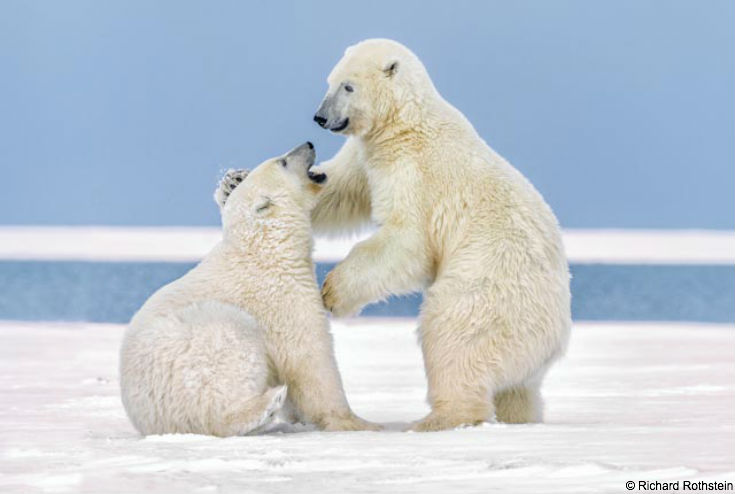Four Things You Should Know About Polar Bears

The start of November can only mean one thing — it’s Polar Bear Week!
Up north in Churchill, Manitoba, polar bears are undertaking their annual migration to Hudson Bay, where sea ice is reforming after summer melts. After a long few months of fasting, the migration marks the bears’ return to their icy seal-hunting grounds where their favorite snacks are ringed and bearded seals. Polar Bear Week is specifically timed to coincide with this migration (meaning you’ll be distracted all week, watching the live polar bear cam!).
Join Ocean Conservancy in celebrating Polar Bear Week. We can’t think of a better way to start the week off right than by brushing up on your polar bear knowledge with these four furry factoids below.
1. Polar bears are superbly adapted to their environment
Polar bears thrive in the Arctic’s harsh climate. A protective outer fur coat paired with a dense undercoat help the bears stay warm in winter temperatures that regularly plunge to below -30° F. They even have fur coating the bottom of their paws, which gives them better traction on the ice and protects them from cold. A dense layer of fat, which can be 2-4 inches thick, further insulates polar bears from the freezing Arctic waters while also helping them stay buoyant as they swim.
Although polar bear fur appears white, it’s actually transparent. The hollow hair shafts reflect light much like ice does, making polar bears appear white or yellow. Beneath their thick coats, polar bears have black skin that better absorbs the sun’s warmth.
2. Polar bears are amazing athletes
Polar bears have swimming skills that would make any Olympic athlete jealous. Their large, slightly webbed paws allow them to swim at a pace of six miles per hour (for comparison, Michael Phelps clocks in around 3.92 miles per hour). Polar bears can also swim more than 60 miles without rest.
Although they spend about 50 percent of their time hunting for food, only 2 percent of their hunts are successful, and they often travel great distances searching for their next meal. One study tracked a female over a nonstop nine day, 426-mile swim – approximately equivalent to driving from Washington, D.C. to Ann Arbor, Michigan.
3. Polar bears are clever hunters
Considered by biologists to be one of the smartest land animals in North America, bears exhibit intricate social structures and can perform complex tasks. Polar bears are incredibly smart and patient hunters, and can remain motionless for hours above a seal’s breathing hole in the ice, waiting for the seal to emerge. They also search for seal lairs, where they will crash through the icy roof and attack the seals inside.
But polar bears are not just crafty hunters; they are also quite playful, and have been observed wrestling with fellow bear “friends” and sliding repeatedly downhill on ice for fun. It’s not all fun and games though—play is an important part of cub development and helps them practice skills they will later use to hunt and protect themselves.
4. Polar bears are in trouble (but you can help!)
Global climate change is bad news for polar bears. Since 1979, sea ice cover in the Arctic has decreased by about 30 percent, meaning polar bears are being pushed ashore (and away from their prey) for longer periods of time. For example, in the Hudson Bay population, polar bears spend about 30 days longer on land than they did 30 years ago. Some polar bears have to walk almost 900 miles in search for smaller food items like berries and kelp that don’t fully meet their nutritional needs. This means less food and more strain on the bears, especially young cubs. Since 1987, the Hudson Bay population has declined by 22 percent. With their habitat melting away beneath their feet, the U.S. Geological Survey predicts that two-thirds of all polar bears could be gone by 2050 if nothing changes.
As if climate change weren’t troublesome enough, the Arctic ecosystem is still not safe from risky offshore drilling. There are no proven methods to effectively clean up oil spilled in Arctic waters, meaning a spill could have devastating and long-lasting impacts on polar bears. Although Shell Oil recently announced that it is retreating from drilling offshore of Alaska for the foreseeable future, the Obama administration is deciding whether to include new Arctic lease sales in a future drilling program. Let’s not go down that road again. Will you help speak up for polar bears – this Polar Bear Week? Please take action by joining myself and Ocean Conservancy in protecting the Arctic from risky drilling.
Can’t get enough of polar bears? We’re spending the next seven days celebrating our favorite Arctic predator with facts, photos and more goodies on our social media sites, so be sure to follow us on Facebook, Twitter and Instagram. Also, check out Polar Bears International for more ways you can help the polar bears.